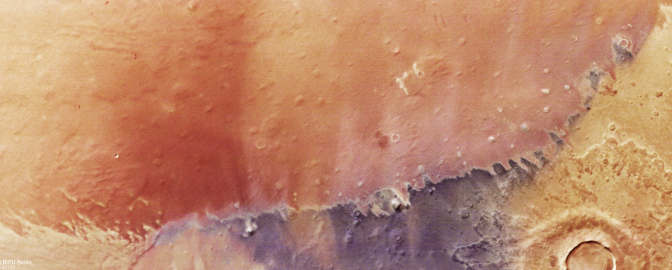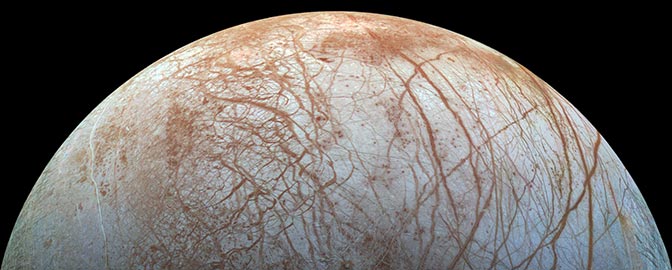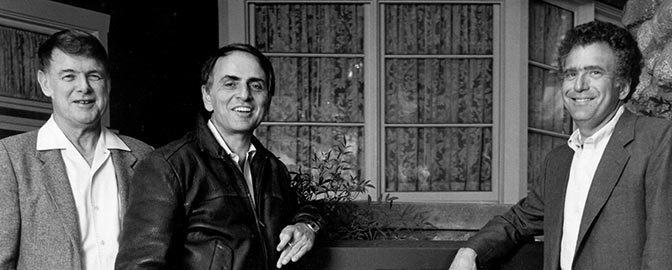The Downlink • Nov 14, 2025
Putting the pieces together
Space Snapshot

This striking image shows solar magnetic activity in action. Created by combining nine days of observational data collected by the ESA/NASA Solar Orbiter spacecraft’s Extreme Ultraviolet Imager, the image shows the Sun's south pole (marked by the white dot), surrounded by bright arcs that show the motion of magnetic structures across its surface. The results contribute to Solar Orbiter’s mission to study how magnetic field dynamics at the poles affect the Sun’s 11-year activity cycle. Image credit: ESA/NASA/Solar Orbiter/EUI-Team.
Fact Worth Sharing
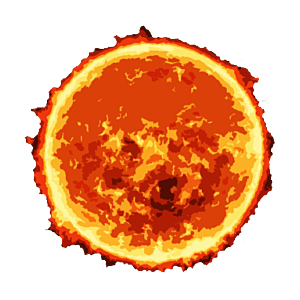
Because different parts of the Sun move at different speeds as it rotates, its magnetic field lines can become tangled, forming knots and loops. Those distortions manifest on the Sun’s surface as sunspots, solar flares, and coronal mass ejections.
Mission Briefings


A key antenna in NASA’s Deep Space Network is damaged. The 70-meter (230-foot) DSS-14 antenna (pictured) in Goldstone, California, is one of the largest in a global network used for communicating with spacecraft in deep space, particularly those in the outer Solar System. NASA’s Jet Propulsion Laboratory confirmed this week that DSS-14 has been offline since Sept. 16, with no timetable for its return to service. Image credit: NASA/JPL-Caltech.

China has delayed the return of a space station crew after a potential impact from space debris. The Shenzhou-20 crew was due to return from the Tiangong-3 space station on Nov. 5 after a six-month mission, but had to remain on board due to concerns that their vehicle had been struck by a piece of space debris. Their return date remains unclear.

ESA is launching a project to study food production in space. The HOBI-WAN (Hydrogen Oxidizing Bacteria In Weightlessness As a source of Nutrition) project aims to test the production of Solein — a powdered protein made from microbes, air, and electricity via a gas fermentation process — in microgravity aboard the International Space Station. The twist? Part of the process involves harvesting an organic compound called urea from the urine of astronauts.
From The Planetary Society


“We’re made of starstuff.” The famous line comes from Carl Sagan, astronomer, science communicator, and co-founder of The Planetary Society. It poetically addresses the fact that the elements that form our bodies come together in the hearts of stars. We celebrated Carl Sagan Day on Nov. 9 by exploring the science behind this iconic line. Pictured: A series of Hubble Space Telescope images of planet-forming disks around other stars. Image credit: ESA, NASA, et al.

Cast your vote for the Best of 2025. Our annual campaign to celebrate the last year in space is underway, and you can take part! Vote for your favorite space image, pick the best performance by a celestial object, and tell us which Planetary Society accomplishment made the biggest impact for you. Voting is open until the end of November, so be sure to cast your vote today!

Catch up on the latest from Planetary Radio. This week’s episode takes you to the TwitchCon 2025 convention to explore how livestreamers like Moohoodles are bringing space science to new audiences. The episode also features a Space Policy Update on Jared Isaacman’s renomination as NASA Administrator and celebrates the third anniversary of the LightSail 2 mission with Bruce Betts. You can also listen to the latest episode of Planetary Radio: Space Policy Edition, which features a conversation with Lou Friedman, former executive director of The Planetary Society, about how the discovery of a possible biosignature at Cheyava Falls could revive political support for Mars Sample Return.

Coming up in The Planetary Society’s virtual book club: This month, book club members will be reading “The Little Book of Aliens,” an exploration of the biggest questions in our search for extraterrestrial life by astrophysicist Adam Frank. The book club is exclusive to Planetary Society members. Not yet a member? Join today.
What's Up
In the early evening, look for yellowish Saturn in the east, moving across the sky throughout the night. Very bright Jupiter rises in the east a little later and is high overhead before dawn. Super bright Venus is very low in the predawn east. The Leonid meteor shower peaks overnight between Nov. 17 and 18. Find out what else to look for in November’s night skies.
Help save space missions. Join today!

If you are not already a member, we need your help. NASA is at a crossroads, and your support is needed today! Funding for space science and exploration is at risk. It needs the support of passionate advocates like you.
NASA is facing major budget cuts for the first time in a decade, and thousands of skilled scientists, engineers, and technicians have already been laid off at NASA centers across the United States. NASA funding must grow, not shrink, if the agency is to succeed in returning to the Moon, exploring the Solar System, and seeking out life beyond Earth.
We must prevent budget cuts. When you become a member of The Planetary Society, you join the world’s largest and most influential space advocacy nonprofit. Will you join us and enable the future of space exploration?
Wow of the Week

Science is all about putting the pieces together — data, observations, and, of course, logical deductions. For Planetary Society member Gavin Frost, it’s also about assembling awesome LEGO sets. Gavin, 16, shared this photo of his completed 3D LEGO Milky Way set in the online member community. Image credit: Gavin Frost.
Send us your artwork!
We love to feature space artwork in the Downlink. If you create any kind of space-related art, we invite you to send it to us by replying to any Downlink email or writing to [email protected]. Please let us know in your email if you’re a Planetary Society member!


 Explore Worlds
Explore Worlds Find Life
Find Life Defend Earth
Defend Earth